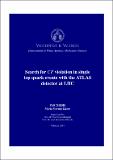Por favor, use este identificador para citar o enlazar a este item:
http://hdl.handle.net/10261/112143COMPARTIR / EXPORTAR:
 SHARE
BASE SHARE
BASE
|
|
| Visualizar otros formatos: MARC | Dublin Core | RDF | ORE | MODS | METS | DIDL | DATACITE | |

| Título: | Search for CP violation in single top quark events with the ATLAS detector at LHC |
Autor: | Moreno Llácer, María CSIC ORCID | Director: | Costa, María José CSIC ORCID; Bernabéu, José | Fecha de publicación: | 23-jun-2014 | Editor: | CSIC-UV - Instituto de Física Corpuscular (IFIC) | Resumen: | The elementary particles, their properties and their interactions are described by the SM, which is the theoretical framework constructed for the study of the strong interactions of quarks and gluons and the unified electroweak force and that is based on local gauge invariance. The SM is very successful in giving account of most of the observed phenomena at the microscopic frontier of physics, having been verified and tested in many experiments in the last decades. The SM has also induced the search of novel phenomena, such as the recent discovery of the Higgs boson by the ATLAS and CMS experiments at the LHC. Despite these spectacular successes, there are evidences that the theory cannot be complete since, besides some possible theoretical diseases (the hierarchy problem), it is unable to explain some observed phenomena in nature. First of all, it does not include gravity and its constituents can only account for around 5% of the energy-matter content of our universe and no SM particle can be a candidate to describe dark matter. Furthermore, the observation of neutrino oscillations implies neutrino mass and mixing, incompatible with the minimal version of the SM. And, in addition, the standard flavour physics framework for CP violation, the mismatch between weak interaction and mass eigenstates of quarks by means of the CKM mixing matrix, is unable to explain the baryon asymmetry of the universe by many orders of magnitude. Although precision experiments in the K and B meson facilities agree with the predictions of the SM, new physics sources of CP violation are unavoidable. With all this, it is clear that extensions of the SM are needed. New physics models that modify the SM in ways subtle enough to be consistent with existing data are being proposed. In this thesis, an extension of the SM with additional sources of CP violation in the top quark sector is proposed. | Descripción: | 258 páginas. Tesis Doctoral del Departamento de Física Atómica, Molecular y Nuclear de la Universidad de Valencia y del Instituto de Física Corpuscular (IFIC). | URI: | http://hdl.handle.net/10261/112143 |
| Aparece en las colecciones: | (IFIC) Tesis |
Ficheros en este ítem:
| Fichero | Descripción | Tamaño | Formato | |
|---|---|---|---|---|
| MariaMorenoLlacer_PhDThesis.pdf | 10,27 MB | Adobe PDF |  Visualizar/Abrir |
CORE Recommender
Page view(s)
202
checked on 22-abr-2024
Download(s)
547
checked on 22-abr-2024
Google ScholarTM
Check
NOTA: Los ítems de Digital.CSIC están protegidos por copyright, con todos los derechos reservados, a menos que se indique lo contrario.
